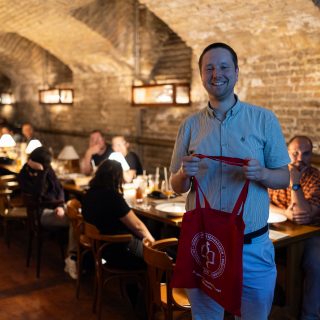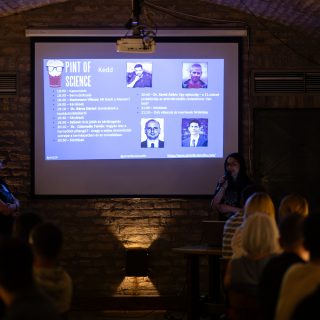Everyone knows that many good ideas, deep insights, or groundbreaking thoughts often come to mind while sitting around a table, holding a drink. Well, the PINT OF SCIENCE festival is built exactly on this: presenting science in an informal setting, a friendly atmosphere, and a relaxed mood. But what exactly is this festival?
PINT OF SCIENCE is not just a scientific event but a true community-building experience, brought to life in May 2013 by Dr. Michael Motskin and Dr. Praveen Paul, two researchers from Imperial College London. Researchers, scientists, and enthusiasts meet to share or learn about the latest discoveries, exchange ideas, and ask questions, diving together into the world of science over a drink. Since then, the festival has spread worldwide, and it doesn’t matter how experienced you are in the scientific field; the event is open to everyone. The essence is that the biggest names in their fields understandably explain their work, whether the audience is laic or an expert.
Hungary joined the initiative in 2023. This year, in 2024, the events were held from May 13 to 15 at Stex and Hoff House in Budapest. The University of Veterinary Medicine Budapest was represented by two excellent young scientists, Dr. Ádám Kerek, an antimicrobial resistance researcher, and Dr. Bence Somoskői, a reproductive biologist.
Let’s start the event report with a stunning figure: as of today, approximately 10,000,000 children have been born worldwide thanks to IVF (“in vitro fertilization”). This number increases by about 600,000 to 700,000 every year, meaning that several million couples have had the opportunity to have children thanks to this procedure, successfully carried out since 1978. In parallel, about 1,200,000 embryo transfers are performed annually in cattle alone. It is evident that technology has significant economic and health importance, yet the average person knows very little about it.
Dr. Bence Somoskői, a reproductive biologist, seized the opportunity to summarize the basics of in vitro fertilization (“IVF”), explaining the main technological steps of the process. He summarized the purpose of the procedure in human healthcare and animal breeding. He also covered methods that help select the healthiest embryo and ensure fertility preservation, even during chemotherapy. Of course, related procedures such as preimplantation genetic diagnosis or time-lapse embryo monitoring—which help embryologists select the healthiest embryo before implantation (embryo transfer)—were discussed. He also addressed ovarian tissue freezing—a fertility preservation method that can be applied even to prepubescent girls—and the isolation, storage, and in vitro culture of preantral follicles, which allows the preservation of eggs from suddenly deceased, high genetic value females, generating many questions from the audience.
Dr. Ádám Kerek’s research focuses on the globally concerning issue of antimicrobial resistance. This phenomenon, which means the reduced effectiveness of antibiotics, is a serious threat to both animal and public health. With the explosive growth of the world’s population, food safety poses increasing challenges for experts. This has resulted in intensive animal farming, leading to the overuse of antibiotics. In sectors like the poultry industry and other livestock sectors, antibiotics began to be used not only for treatment but also for disease prevention. This bad practice poses a danger to both the environment and human health, as it leads to the development and widespread dissemination of antibiotic-resistant bacteria, indirectly contributing to the continuous increase in fatal infections. At the current trends, antimicrobial resistance could become the leading cause of death globally by 2050.
The solution is not simple, but following the One Health principle, both human and veterinary medicine play a central role in addressing the problem. Alongside regular monitoring and more careful, targeted use of antibiotics, researching alternative solutions also plays a crucial role in curbing resistance. Therefore, what is needed above all is joint thinking, public education, and of course, the application of knowledge in everyday life.
The goal of the researchers from the University of Veterinary Medicine Budapest in participating in the PINT OF SCIENCE festival was to communicate directly with the audience, helping to make scientific results transparent and acquainting people with real challenges and possible solutions.
And what is the takeaway?
Be curious about the latest scientific findings, have questions, seek answers, follow our page, and if you missed it this year, don’t hesitate to join the PINT OF SCIENCE events next year!
Photos: Tamás Tóth















